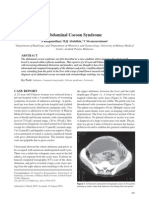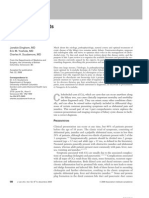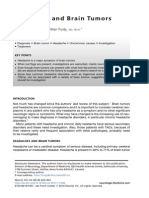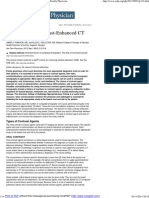Rep Gastroenter
Rep Gastroenter
Uploaded by
Duddy Ari HardiantoCopyright:
Available Formats
Rep Gastroenter
Rep Gastroenter
Uploaded by
Duddy Ari HardiantoCopyright
Available Formats
Share this document
Did you find this document useful?
Is this content inappropriate?
Copyright:
Available Formats
Rep Gastroenter
Rep Gastroenter
Uploaded by
Duddy Ari HardiantoCopyright:
Available Formats
Case Rep Gastroenterol 2013;7:164168
DOI: 10.1159/000350253
Published online: March 21, 2013
2013 S. Karger AG, Basel
16620631/13/00710164$38.00/0
www.karger.com/crg
This is an Open Access article licensed under the terms of the Creative Commons AttributionNonCommercial-NoDerivs 3.0 License (www.karger.com/OA-license), applicable to the
online version of the article only. Distribution for non-commercial purposes only.
Diverticular Choledochal Cyst with a
Large Impacted Stone Masquerading
as Mirizzis Syndrome
Soon Oh Hwang a Tae Hoon Lee a Sang Ho Bae b Dong Jae Han a
Han Min Lee a Sang-Heum Parka Chang Ho Kimb Sun-Joo Kima
Departments of a Internal Medicine and b General Surgery, Soon Chun Hyang University
College of Medicine, Cheonan Hospital, Cheonan, Republic of Korea
Key Words
Choledochal cyst Mirizzis syndrome Cholangitis
Abstract
Choledochal cysts are congenital anomalies of the biliary tract manifested by cystic dilatation
of the extrahepatic and intrahepatic bile ducts. Choledochal cyst is not rare in far-East Asian
countries. Type II choledochal cysts account for 2% of all such cysts. They are true diverticula
of the extrahepatic bile duct and communicate with the bile duct through a narrow stalk. This
condition is associated with significant complications, such as ductal strictures, stone formation, cholangitis, rupture and secondary biliary cirrhosis. We describe a case of a huge
impacted stone in a diverticular choledochal cyst which masqueraded as an unusual cystic
duct stone causing Mirizzis syndrome.
Introduction
Choledochal cysts are congenital anomalies of the biliary tract manifested by cystic
dilatation of the extrahepatic and intrahepatic bile ducts. Choledochal cysts are rare, and
their incidence is higher in Asian than Western countries [1, 2]. The majority of them are
diagnosed during the first decade of life, but around 20% are not diagnosed until adulthood
[3]. Presentation of choledochal cysts in adults differs from their presentation in children in
the way that these are more commonly associated with hepatobiliary pathology, such as
cholangitis, cystolithiasis, pancreatitis, pancreatic duct abnormalities and malignancy. The
widely accepted classification system for choledochal cysts, which was devised by Todani et
al. [4], is based on cholangiographic morphology, location and number of intrahepatic and
Tae Hoon Lee, MD, PhD
Department of Internal Medicine
Soon Chun Hyang University College of Medicine
Digestive Disease Center, Soon Chun Hyang University Cheonan Hospital
16-31 Soonchunhyang-ro, Dongnam-gu, Cheonan 330-721 (Republic of Korea)
E-Mail thlee9@schmc.ac.kr
165
Case Rep Gastroenterol 2013;7:164168
DOI: 10.1159/000350253
2013 S. Karger AG, Basel
www.karger.com/crg
Hwang et al.: Diverticular Choledochal Cyst with a Large Impacted Stone
Masquerading as Mirizzis Syndrome
extrahepatic bile duct cysts. Type II choledochal cyst is a very rare true congenital diverticulum of the extrahepatic bile duct and a potential precursor of cholangiocarcinoma [3, 57].
Cystolithiasis and cholecystolithiasis are the most frequent conditions, occurring in 70% of
adults with choledochal cysts [3]. However, the frequency of these conditions according to
the type of choledochal cyst has not been estimated. Impacted stones are extremely rare in
type II choledochal cysts and, to our knowledge, have not been reported in the English language literature.
We describe the unusual case of a huge impacted stone in a diverticular choledochal cyst
which masqueraded as an unusual cystic duct stone causing Mirizzis syndrome. The diagnosis in this case was confirmed by laparoscopic exploration.
Case Report
A 24-year-old male presented with recurrent abdominal pain that had started to worsen
2 months previously. He had no relevant family or past medical history. On admission, his
vital signs were stable. Physical examination revealed slight tenderness in the epigastric area
with no sign of peritoneal irritation. Biochemical investigations yielded the following findings: white blood cell count 6,300/mm3, serum glucose 93 mg/dl, total bilirubin 1.1 mg/dl,
aspartate aminotransferase 28 IU/l, alanine aminotransferase 13 IU/l, alkaline phosphatase
61 IU/l, gamma-glutamyltransferase 28 IU/l, amylase 115 IU/l, lipase 45 U/l, alpha-fetoprotein 2.07 ng/ml, carbohydrate antigen 19-9 23.68 U/ml, carcinoembryonic antigen 4.05 ng/
ml and high-sensitivity C-reactive protein 0.3 mg/l.
Abdominal computed tomography showed a large stone in the common bile duct (CBD)
with no marked upstream duct dilatation, and magnetic resonance cholangiopancreatography (MRCP) demonstrated the same stone at the same level with compression of the CBD,
suggesting Mirizzis syndrome. The location of the impacted stone was suspected to be the
cystic duct rather than the CBD, which could cause compression of the CBD (fig. 1a). Subsequent endoscopic retrograde cholangiopancreatography (ERCP) showed that the large impacted stone was located in the central CBD. Injected contrast filled the dilated upstream
cystic duct and CBD at the same time and demonstrated that the large stone was laterally
compressing the CBD (fig. 1b). This finding strongly suggested that an impacted stone in the
cystic duct of the gallbladder had caused Mirizzis syndrome. Selective CBD cannulation was
difficult due to the narrowing caused by extrinsic compression and variation in the common
pathway of the CBD. However, the gallbladder was not distended and laboratory findings
revealed no obstructive pattern typically seen in Mirizzis syndrome. Following the insertion
of a 7-Fr plastic stent (Cook Endoscopy, Winston-Salem, N.C., USA) into the CBD, laparoscopic cholecystectomy was planned.
Laparoscopic operative findings showed that the gallbladder was atrophic; thus, the surgeon planned to perform laparoscopic cholecystectomy and to remove the impacted stone
via CBD exploration. Intraoperatively, the stone in the CBD was considered to be impacted
due to the atrophic gallbladder. However, following removal of the gallbladder and the large
impacted stone, surgical exploration revealed a bulging cystic lesion and the surgeon could
not find the plastic stent inserted previously in the CBD (fig. 2). Thus, the surgery was converted to laparotomy, which revealed that the saccular dilated cystic lesion with a large
impacted stone was a diverticular choledochal cyst. The type II choledochal cyst was excised
and choledochoduodenostomy was performed. The final diagnosis was confirmed histologically, the specimen showing chronic inflammatory infiltration without dysplasia and denuded epithelium (fig. 3).
166
Case Rep Gastroenterol 2013;7:164168
DOI: 10.1159/000350253
2013 S. Karger AG, Basel
www.karger.com/crg
Hwang et al.: Diverticular Choledochal Cyst with a Large Impacted Stone
Masquerading as Mirizzis Syndrome
Discussion
The estimated incidence of choledochal cysts in Western countries has ranged from
1/100,000 to 1/150,000 individuals. However, the incidence is higher in Asia, and these
cysts occur more frequently in females (male:female ratio 1:4) [1, 2]. Type II choledochal
cysts appear as diverticula of the CBD, with some cases closely resembling gallbladder
duplication and others resembling rudimentary diverticular structures. Complications of
choledochal cysts in adults include cholecystitis, recurrent cholangitis, biliary stricture, choledocholithiasis, recurrent acute pancreatitis and malignant transformation to cholangiocarcinoma [13]. Although abdominal pain is the most common presenting symptom in adults
[3, 4, 8], most patients have nonspecific clinical symptoms [1, 4, 8, 9]. Choledocholithiasis is a
common complication of choledochal cysts [2], but a diverticular choledochal cyst with an
impacted stone causing diagnostic confusion is extremely rare and difficult to differentiate
using imaging modalities, as described in our case.
ERCP has been regarded as the gold standard for the diagnosis of choledochal cysts and
associated anomalies [10, 11]. Recently, MRCP has replaced ERCP for the assessment of
many pancreaticobiliary diseases. MRCP allows visualization of the biliary and pancreatic
ducts noninvasively and without contrast injection [11, 12]. Delineation of the precise anatomy of the pancreaticobiliary system is critical for optimal surgical management. Choledochal cyst types can be defined more accurately by MRCP than by ERCP [12]. However, the
initial use of MRCP and ERCP in the present case led us to suspect that the patient had an
unusual impacted cystic duct stone causing Mirizzis syndrome. A large stone may be impacted at a low insertion point in a cystic lesion, which would not be captured by the basket
in ERCP.
Currently, optimal treatment of a choledochal cyst is likely to involve complete excision
of the extrahepatic bile duct, cholecystectomy and Roux-en-Y hepaticojejunostomy [8]. In the
present case, laparoscopic cholecystectomy was first attempted based on radiologic and
ERCP findings, but the surgery was converted to laparotomy due to unusual anatomic findings, including gallbladder atrophy above the level of the choledochal cyst, and failure to
locate the previously inserted plastic stent. These findings eventually led to the diagnosis of
a diverticular choledochal cyst with an impacted stone.
In summary, we experienced the very unusual case of a diverticular choledochal cyst
with a huge impacted stone which masqueraded as a cystic duct stone causing Mirizzis
syndrome. The diagnosis was made via surgical exploration. In this case, preoperative
diagnosis and treatment planning were difficult due to the limitations of imaging studies,
including ERCP.
Disclosure Statement
All authors disclose no financial relationships relevant to this publication.
167
Case Rep Gastroenterol 2013;7:164168
DOI: 10.1159/000350253
2013 S. Karger AG, Basel
www.karger.com/crg
Hwang et al.: Diverticular Choledochal Cyst with a Large Impacted Stone
Masquerading as Mirizzis Syndrome
References
1
2
3
4
5
6
7
8
9
10
11
12
Park DH, Kim MH, Lee SK, et al: Can MRCP replace the diagnostic role of ERCP for patients with choledochal
cysts? Gastrointest Endosc 2005;62:360366.
Misra SP, Gulati P, Thorat VK, Vij JC, Anand BS: Pancreaticobiliary ductal union in biliary diseases. An
endoscopic retrograde cholangiopancreatographic study. Gastroenterology 1989;96:907912.
Weyant MJ, Maluccio MA, Bertagnolli MM, Daly JM: Choledochal cysts in adults: a report of two cases and
review of the literature. Am J Gastroenterol 1998;93:25802583.
Todani T, Watanabe Y, Narusue M, Tabuchi K, Okajima K: Congenital bile duct cysts: classification, operative
procedures, and review of thirty-seven cases including cancer arising from choledochal cyst. Am J Surg
1977;134:263269.
Flanigan DP: Biliary carcinoma associated with biliary cysts. Cancer 1977;40:880883.
Song HK, Kim MH, Myung SJ, et al: Choledochal cyst associated the with anomalous union of
pancreaticobiliary duct (AUPBD) has a more grave clinical course than choledochal cyst alone. Korean J
Intern Med 1999;14:18.
Todani T, Tabuchi K, Watanabe Y, Kobayashi T: Carcinoma arising in the wall of congenital bile duct cysts.
Cancer 1979;44:11341141.
Wiseman K, Buczkowski AK, Chung SW, et al: Epidemiology, presentation, diagnosis, and outcomes of
choledochal cysts in adults in an urban environment. Am J Surg 2005;189:527531.
Visser BC, Suh I, Way LW, Kang SM: Congenital choledochal cysts in adults. Arch Surg 2004;139:855862.
Liu YB, Wang JW, Devkota KR, et al: Congenital choledochal cysts in adults: twenty-five-year experience.
Chin Med J 2007;120:14041407.
Lee HK, Park SJ, Yi BH, et al: Imaging features of adult choledochal cysts: a pictorial review. Korean J Radiol
2009;10:7180.
Lenriot JP, Gigot JF, Sgol P, Fagniez PL, Fingerhut A, Adloff M: Bile duct cysts in adults: a multi-institutional
retrospective study. French Associations for Surgical Research. Ann Surg 1998;228:159166.
Fig. 1. a A 2.5-cm-sized heterogeneous SI lesion on the lateral side of the CBD which compressed the duct.
b A huge lesion filled the middle level of the CBD and was suspected to be a portion of the cystic duct or
gallbladder.
168
Case Rep Gastroenterol 2013;7:164168
DOI: 10.1159/000350253
2013 S. Karger AG, Basel
www.karger.com/crg
Hwang et al.: Diverticular Choledochal Cyst with a Large Impacted Stone
Masquerading as Mirizzis Syndrome
Fig. 2. a Laparoscopic view showing an atrophic gallbladder (arrow) and a bulging cystic portion with
suspected impacted stones. b Following gallbladder removal, the cystic dilatation was incised to remove
the impacted stone. Note the removed black stones and exposed choledochal cyst (arrow).
Fig. 3. Pathologic examination confirmed the diagnosis of a true choledochal cyst with no malignant
change (H&E stain, 100).
You might also like
- Cardiovascular Assessment ChecklistDocument2 pagesCardiovascular Assessment Checklistvishnu100% (3)
- Acute Renal FailureDocument35 pagesAcute Renal FailureKaelyn Bello Giray100% (1)
- Easy Guide To MiasmaticsDocument12 pagesEasy Guide To Miasmaticsdbsmanian100% (1)
- Ausencia Congenita Del Conducto Cistico. Mini-Revision 2013Document6 pagesAusencia Congenita Del Conducto Cistico. Mini-Revision 2013Bolivar IseaNo ratings yet
- s13304 011 0131 2 PDFDocument3 pagess13304 011 0131 2 PDFRoderick Núñez JNo ratings yet
- CholedocholithiasisDocument9 pagesCholedocholithiasisOsiithaa CañaszNo ratings yet
- 10-1055-s-0036-1592329Document9 pages10-1055-s-0036-1592329muhamad givariNo ratings yet
- Gobbur Et AlDocument4 pagesGobbur Et AleditorijmrhsNo ratings yet
- An Alternative Surgical Approach To Managed Mirizzi SyndromeDocument3 pagesAn Alternative Surgical Approach To Managed Mirizzi SyndromeYovan PrakosaNo ratings yet
- Choledochal CystDocument14 pagesCholedochal CystIndah SolehaNo ratings yet
- April 2009.caglayan GallstoneileusDocument4 pagesApril 2009.caglayan GallstoneileusDaru KristiyonoNo ratings yet
- TMP CD3Document4 pagesTMP CD3FrontiersNo ratings yet
- Small BowelDocument5 pagesSmall BowelFachry MuhammadNo ratings yet
- Gall Bladder Stones Surgical Treatment by Dr. Mohan SVSDocument5 pagesGall Bladder Stones Surgical Treatment by Dr. Mohan SVSFikri AlfarisyiNo ratings yet
- Choledochal Cyst: SymposiumDocument3 pagesCholedochal Cyst: SymposiumRegi Anastasya MangiriNo ratings yet
- Imaging Signs For Determining Surgery Timing of Acute Intestinal ObstructionDocument7 pagesImaging Signs For Determining Surgery Timing of Acute Intestinal ObstructionshaffaNo ratings yet
- 4 - Stenting For Benign and PDFDocument21 pages4 - Stenting For Benign and PDFMahdi ShareghNo ratings yet
- Asymptomatic Hepatobiliary Cystadenoma of The Hepatic Caudate Lobe A Case ReportDocument3 pagesAsymptomatic Hepatobiliary Cystadenoma of The Hepatic Caudate Lobe A Case ReportquileuteNo ratings yet
- Chronic Empyaema Gall BladderDocument2 pagesChronic Empyaema Gall BladderSuresh Kalyanasundar (Professor)No ratings yet
- Iatrogenic Injury To The Common Bile Duct: Case ReportDocument3 pagesIatrogenic Injury To The Common Bile Duct: Case ReportGianfranco MuntoniNo ratings yet
- Cholelithiasis With Choledocholithiasis: Epidemiological, Clinical ProfileDocument3 pagesCholelithiasis With Choledocholithiasis: Epidemiological, Clinical ProfileShashank KumarNo ratings yet
- tmpC401 TMPDocument3 pagestmpC401 TMPFrontiersNo ratings yet
- 201 203 AbdominalDocument3 pages201 203 AbdominalManal Salah DorghammNo ratings yet
- Surgical Management of The Horrible GallbladderDocument18 pagesSurgical Management of The Horrible GallbladderbcgburanelloNo ratings yet
- April 2009.caglayan-Gallstoneileus PDFDocument4 pagesApril 2009.caglayan-Gallstoneileus PDFYai El BaRcaNo ratings yet
- Modern Imaging in Obstructive JaundiceDocument4 pagesModern Imaging in Obstructive JaundicedanaogreanuNo ratings yet
- 3 - ColedocolitiasisDocument8 pages3 - ColedocolitiasisMario Perez RumboNo ratings yet
- 2017-05 Norfolk and Waveney CPDG Policy Briefing Paper - Capsule EndoscoDocument4 pages2017-05 Norfolk and Waveney CPDG Policy Briefing Paper - Capsule EndoscoAlessioNavarraNo ratings yet
- Choledocholithiasis: Evolving Standards For Diagnosis and ManagementDocument6 pagesCholedocholithiasis: Evolving Standards For Diagnosis and ManagementAngel Princëzza LovërzNo ratings yet
- tài liệu tham khảoDocument1 pagetài liệu tham khảohằng nguyễnNo ratings yet
- Jurnal 2Document10 pagesJurnal 2Siska Eni WijayantiNo ratings yet
- Article 1615981002 PDFDocument3 pagesArticle 1615981002 PDFMaria Lyn Ocariza ArandiaNo ratings yet
- International Journal of Surgery Case Reports: Adenocarcinoma in An Ano-Vaginal Fistula in Crohn's DiseaseDocument4 pagesInternational Journal of Surgery Case Reports: Adenocarcinoma in An Ano-Vaginal Fistula in Crohn's DiseaseTegoeh RizkiNo ratings yet
- Gallbladder Cancer - Expert Consensus StatementDocument10 pagesGallbladder Cancer - Expert Consensus StatementAbunoor AbunoorNo ratings yet
- International Journal of Surgery Case ReportsDocument5 pagesInternational Journal of Surgery Case ReportsMuhammad Fuad MahfudNo ratings yet
- 48 Kalpana EtalDocument3 pages48 Kalpana EtaleditorijmrhsNo ratings yet
- Intestinal Obstruction Secondary To Colon CancerDocument43 pagesIntestinal Obstruction Secondary To Colon CancerNiel LeeNo ratings yet
- Choledochal Cysts: Part 2 of 3: DiagnosisDocument6 pagesCholedochal Cysts: Part 2 of 3: DiagnosisKarla ChpNo ratings yet
- B - Bile Duct Injuries in The Era of Laparoscopic Cholecystectomies - 2010Document16 pagesB - Bile Duct Injuries in The Era of Laparoscopic Cholecystectomies - 2010Battousaih1No ratings yet
- Nonneoplastic Diseases of The Small Intestine: Differential Diagnosis and Crohn DiseaseDocument9 pagesNonneoplastic Diseases of The Small Intestine: Differential Diagnosis and Crohn DiseaseWhy DharmawanNo ratings yet
- Surgical Endoscopy Apr1998Document95 pagesSurgical Endoscopy Apr1998Saibo BoldsaikhanNo ratings yet
- Infected Urachal Cyst in An Adult A Case Report and Review of The LiteratureDocument3 pagesInfected Urachal Cyst in An Adult A Case Report and Review of The LiteratureAhmad Ulil AlbabNo ratings yet
- The Role of Endoscopy in The Management of Patients With Known and Suspected Colonic Obstruction and Pseudo-ObstructionDocument11 pagesThe Role of Endoscopy in The Management of Patients With Known and Suspected Colonic Obstruction and Pseudo-ObstructionTëssaNovamitchNo ratings yet
- Crigm2019 8907068Document4 pagesCrigm2019 8907068AlixNo ratings yet
- Hirschprung DiseaseDocument10 pagesHirschprung DiseaseTsania RebelNo ratings yet
- 06.emergency Surgery - Small Bowel ObstructionDocument9 pages06.emergency Surgery - Small Bowel ObstructionArthur YanezNo ratings yet
- 1 s2.0 S0022480423002895 MainDocument7 pages1 s2.0 S0022480423002895 Mainlucabarbato23No ratings yet
- Ogilvie Syndrome After Emergency Cesarean Section: A Case ReportDocument4 pagesOgilvie Syndrome After Emergency Cesarean Section: A Case ReportIJAR JOURNALNo ratings yet
- It Is Not Always A Cholangiocarcinoma: Unusual Peritoneal Carcinomatosis Revealing Gastric AdenocarcinomaDocument5 pagesIt Is Not Always A Cholangiocarcinoma: Unusual Peritoneal Carcinomatosis Revealing Gastric AdenocarcinomaIJAR JOURNALNo ratings yet
- Thesis Statement For Ulcerative ColitisDocument7 pagesThesis Statement For Ulcerative Colitisafkodpexy100% (2)
- Liver Abscess DissertationDocument4 pagesLiver Abscess DissertationPayForAPaperAtlanta100% (1)
- Ijrms-12417 CDocument5 pagesIjrms-12417 CSamuel MedinaNo ratings yet
- 3Fwjfx "Sujdmf &BSMZ %jbhoptjt PG (Bmmcmbeefs $bsdjopnb "O "Mhpsjuin "QqspbdiDocument6 pages3Fwjfx "Sujdmf &BSMZ %jbhoptjt PG (Bmmcmbeefs $bsdjopnb "O "Mhpsjuin "QqspbdiabhishekbmcNo ratings yet
- The Gallbladder Diseases Bile Duct StoneDocument69 pagesThe Gallbladder Diseases Bile Duct Stoneحميد حيدرNo ratings yet
- 44 Danfulani EtalDocument3 pages44 Danfulani EtaleditorijmrhsNo ratings yet
- Heterotopic Pancreas of The Gallbladder Associated With Chronic CholecystitisDocument3 pagesHeterotopic Pancreas of The Gallbladder Associated With Chronic CholecystitisAziz EzoNo ratings yet
- Small Bowel Obstruction - StatPearls - NCBI BookshelfDocument6 pagesSmall Bowel Obstruction - StatPearls - NCBI BookshelfSitti Hannah M. RonquilloNo ratings yet
- Per-Operative Conversion of Laparoscopic Cholecystectomy To Open Surgery: Prospective Study at JSS Teaching Hospital, Karnataka, IndiaDocument5 pagesPer-Operative Conversion of Laparoscopic Cholecystectomy To Open Surgery: Prospective Study at JSS Teaching Hospital, Karnataka, IndiaSupriya PonsinghNo ratings yet
- Schwartz2002 PDFDocument7 pagesSchwartz2002 PDFnova sorayaNo ratings yet
- Choledocal CystDocument11 pagesCholedocal CystBilly JonatanNo ratings yet
- Argh - Ms.id.555581, DR Muhammad Zafar Mengal ArticlesDocument4 pagesArgh - Ms.id.555581, DR Muhammad Zafar Mengal ArticlesMuhammad Zafar MengalNo ratings yet
- Fast Facts: Cholangiocarcinoma: Diagnostic and therapeutic advances are improving outcomesFrom EverandFast Facts: Cholangiocarcinoma: Diagnostic and therapeutic advances are improving outcomesNo ratings yet
- The SAGES Manual of Biliary SurgeryFrom EverandThe SAGES Manual of Biliary SurgeryHoracio J. AsbunNo ratings yet
- FromUltrasoundDiagnosist 2013Document4 pagesFromUltrasoundDiagnosist 2013Duddy Ari HardiantoNo ratings yet
- Headachesandbraintumors: Sarah Kirby,, R. Allan PurdyDocument10 pagesHeadachesandbraintumors: Sarah Kirby,, R. Allan PurdyDuddy Ari HardiantoNo ratings yet
- Safety of Radiographic Imaging During Pregnancy - American Family PhysicianDocument7 pagesSafety of Radiographic Imaging During Pregnancy - American Family PhysicianDuddy Ari HardiantoNo ratings yet
- Cancer Presenting During Pregnancy: Radiological PerspectivesDocument15 pagesCancer Presenting During Pregnancy: Radiological PerspectivesDuddy Ari HardiantoNo ratings yet
- Pregnancy and Brain TumourDocument10 pagesPregnancy and Brain TumourDuddy Ari HardiantoNo ratings yet
- Bladder 8Document9 pagesBladder 8Duddy Ari HardiantoNo ratings yet
- When To Order Contrast-Enhanced CT - American Family PhysicianDocument9 pagesWhen To Order Contrast-Enhanced CT - American Family PhysicianDuddy Ari HardiantoNo ratings yet
- Malformation GlioblastomaDocument10 pagesMalformation GlioblastomaDuddy Ari HardiantoNo ratings yet
- Poultry Press (Winter 2011-2012)Document11 pagesPoultry Press (Winter 2011-2012)Vegan FutureNo ratings yet
- RADIOLOGY OF KNEE For StudentDocument70 pagesRADIOLOGY OF KNEE For Studentjamie mutucNo ratings yet
- Yagatipura HWC, NQAS Reporting FormatsDocument5 pagesYagatipura HWC, NQAS Reporting FormatskadhwcyagatipuraNo ratings yet
- Xi Cleft (Accumulation Point) : DiagnosisDocument4 pagesXi Cleft (Accumulation Point) : DiagnosisZareen FNo ratings yet
- USA - BioFire - EC - 01232023Document4 pagesUSA - BioFire - EC - 01232023yousrazeidan1979No ratings yet
- Genetics Review Questions KeyDocument37 pagesGenetics Review Questions KeyRyan Christian PatriarcaNo ratings yet
- Social Issues Effecting BarbadosDocument38 pagesSocial Issues Effecting BarbadosKenny BowenNo ratings yet
- Roleplay FractureDocument5 pagesRoleplay FractureGanji GakkenNo ratings yet
- QUANTA Lite H-TTG Screen ELISA 704570 - InovaDocument8 pagesQUANTA Lite H-TTG Screen ELISA 704570 - InovayyewelsNo ratings yet
- DaburDocument59 pagesDaburAnkush Mahajan60% (5)
- Cardiovascular Pharmacology) 01 Antiplatelet Meds - KeyDocument1 pageCardiovascular Pharmacology) 01 Antiplatelet Meds - KeyyenkaneetensNo ratings yet
- Chapter 11Document23 pagesChapter 11deepmazumderNo ratings yet
- Epilepsy EpilepsyDocument8 pagesEpilepsy EpilepsyJobelle AcenaNo ratings yet
- FICHES METHODE ANGLAIS FR VocabulaireDocument63 pagesFICHES METHODE ANGLAIS FR Vocabulairehajar razikNo ratings yet
- tina histamine graduation paper reviewed printDocument32 pagestina histamine graduation paper reviewed printTihitina GetachewNo ratings yet
- Ian Stevenson Replies To Leonard AngelDocument5 pagesIan Stevenson Replies To Leonard AngelBen Steigmann100% (1)
- UWorld Cards July 14Document7 pagesUWorld Cards July 14smian08No ratings yet
- 9HAIRDRESSING q1 Module1 Hair and Scalp TreatmentDocument25 pages9HAIRDRESSING q1 Module1 Hair and Scalp TreatmentLeslie Ann TanNo ratings yet
- Study of Foreign Body OesophagusDocument3 pagesStudy of Foreign Body OesophagusAnonymous ST1Ot2GAHxNo ratings yet
- Vasa PraeviaDocument3 pagesVasa PraeviaAngelica CabututanNo ratings yet
- Kenya National Cancer Control StrategyDocument38 pagesKenya National Cancer Control StrategynonimugoNo ratings yet
- 02 Unpacking The Self (Physical and Sexual)Document27 pages02 Unpacking The Self (Physical and Sexual)Brilliant Jay LagriaNo ratings yet
- Pidsr2011annual ReportDocument55 pagesPidsr2011annual ReportApril GuiangNo ratings yet
- Veterinary Pharmacology Toxicology PDFDocument11 pagesVeterinary Pharmacology Toxicology PDFSandeep Kumar Chaudhary55% (11)
- Mesenchymal Stromal Cells: Potential For Cardiovascular RepairDocument19 pagesMesenchymal Stromal Cells: Potential For Cardiovascular RepairardhanputraNo ratings yet
- CDT B1 Lab06 MondayWeek2Document6 pagesCDT B1 Lab06 MondayWeek2Agung Arif Nur WibowoNo ratings yet
- Infeksi Parasit Di Saluran Cerna: 15 April 2014Document69 pagesInfeksi Parasit Di Saluran Cerna: 15 April 2014Rangga DarmawanNo ratings yet

































































































